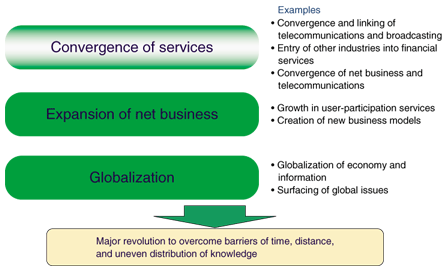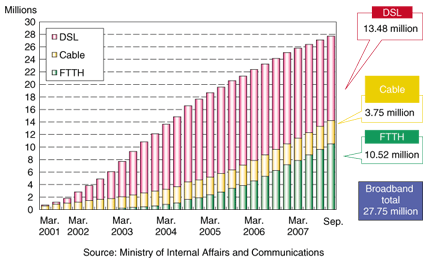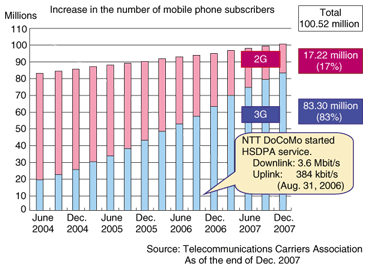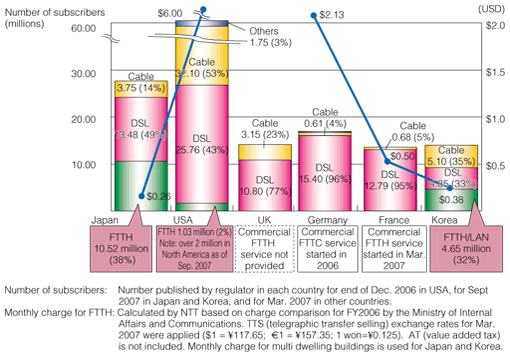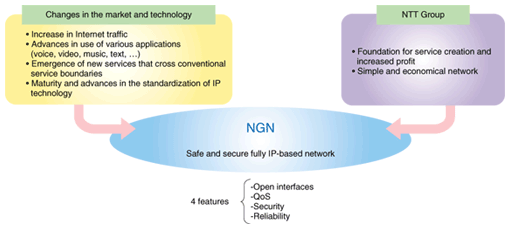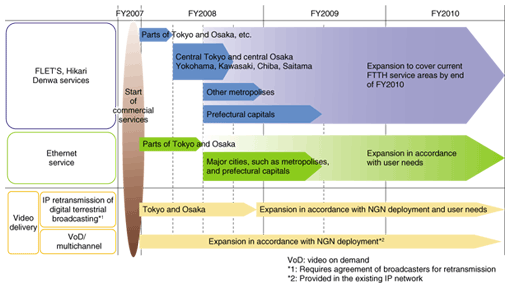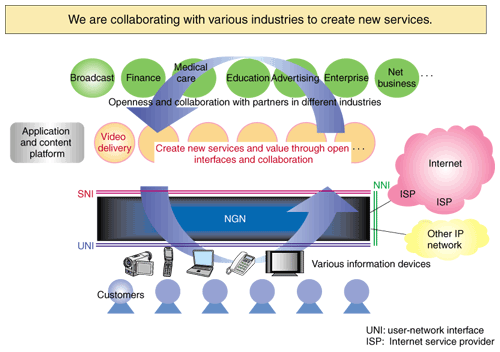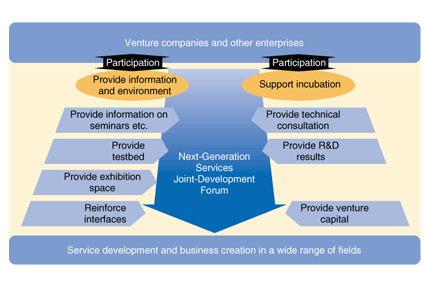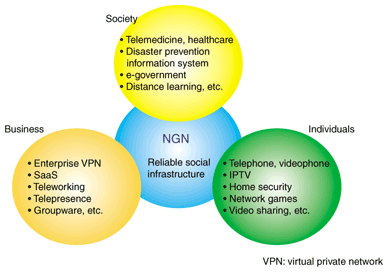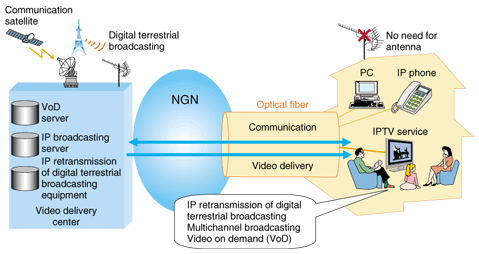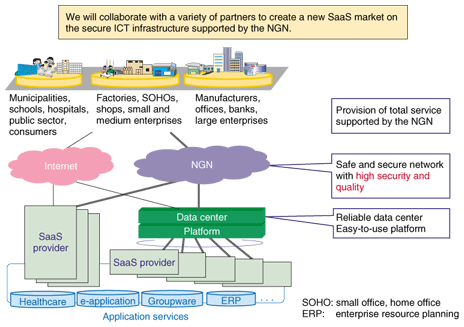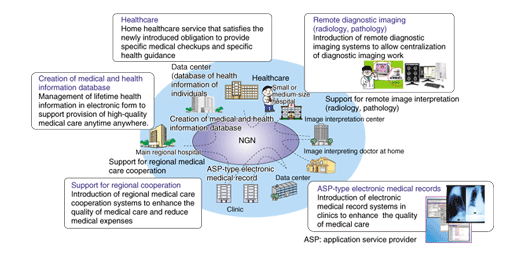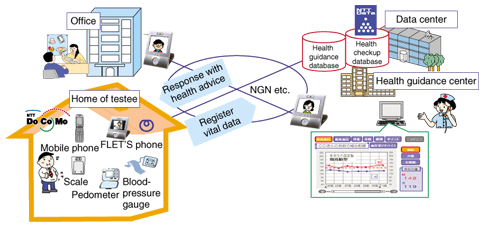 |
|||||||||||||||||||
|
|
|||||||||||||||||||
|
Special Feature: Keynote Speeches at NTT R&D Forum 2008 Vol. 6, No. 4, pp. 1–11, Apr. 2008. https://doi.org/10.53829/ntr200804sf1 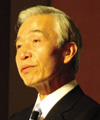 NTT's Activities to Promote the Advance of the Ubiquitous Broadband SocietyAbstractThis article discusses the changes in society brought about by the spread of information communications technology (ICT) and the activities of the NTT Group aimed at the deployment of the Next-Generation Network (NGN). It is based on the lecture presented by Satoshi Miura, President and CEO of NTT, at the NTT R&D Forum 2008 held on February 7–8, 2008. 1. Trends in information communications and changes in society1.1 Structural changes in society brought about by ICTThe rapid progress in information communications technology (ICT) has brought about a significant change in the structure of society, as shown in Fig. 1.
First of all, telecommunications and broadcasting are converging. Within the telecommunications field, convergence is seen between fixed-line and mobile services. Service convergence is also seen in the financial industry, where electronic money is touted by railway companies, supermarkets, and convenience store operators. Internet-based businesses are enjoying a rapid expansion. User-participation services, such as weblogs (blogs) and social networking services (SNSs) are gaining in popularity. New services and business models, such as software as a service (SaaS) and a virtual world called “Second Life,” have emerged and are seeing a steady increase in users. Globalization is another distinctive change that is taking place. These days, people can access information anywhere in the world instantly through the Internet. Manufacturing and other industries are increasing their overseas presence and offshore development. Enterprises in the USA, for example, are increasingly making use of global networks to outsource their call centers to India and other countries. They are not only looking at low labor costs but also taking advantage of time differences to provide a 24/7 service (24 hours a day, 7 days a week). This is an era characterized by a dramatic revolution that is overcoming the barriers of time, distance, and uneven distribution of knowledge. As a telecommunications carrier, we must adapt to these dramatic changes that span the existing frameworks of industries and services and national borders. 1.2 Increase in the number of broadband access subscribersThe above-mentioned changes have been supported by the increasing availability of broadband services. The increase in the number of broadband access subscribers in Japan is shown in Fig. 2. The total number of DSL (digital subscriber line), cable, and FTTH (fiber-to-the-home) subscribers reached almost 28 million at the end of September 2007. Out of this total, the number of FTTH subscribers exceeded 10 million. This implies that super-high-speed broadband access has made deep inroads into our daily lives and various activities in society at large.
1.3 Penetration of 3G mobile phonesA steady drift towards high-speed access has been seen in mobile phone services. The number of mobile phone subscribers in Japan exceeded 100 million in December 2007 (Fig. 3). More than 80% of these subscribers are using 3G (third-generation systems).
NTT DoCoMo now provides a 3.5G service (HSDPA: high-speed download packet access), in which the maximum downlink speed is as high as 3.6 Mbit/s. It plans to provide even faster services using new technologies, such as HSPA (high-speed packet access), which increases the uplink speed as well, and Super3G. A shift to broadband access and a broader mode of access is taking place in other wireless services. Wireless local area network access (WiFi) is already up and running, and high-speed wireless access (WiMAX) will be provided. 1.4 Trends in other countriesThe number of broadband access subscribers in several countries is shown in Fig. 4. The line chart compares the monthly charges for FTTH per 1 Mbit/s in these countries. As far as FTTH, shown in green, is concerned, Japan tops the world both in the number of subscribers and affordability. I remember that, when I visited investors and carriers abroad as part of my investor relations activities, I was told that it was crazy to provide an FTTH service. But in the last few years, such an opinion has rarely been voiced, if at all. Korea and the USA are also pushing ahead with the introduction of FTTx*, and other countries are beginning to make serious efforts to provide such services. It would not be an overstatement to say that the shift to FTTx is now a solid worldwide movement.
1.5 Rapid growth in Internet trafficThe increase in broadband access, as described above, has advanced the use of the Internet, which has led to rapid growth in Internet traffic. The total download traffic of broadband access users in Japan was estimated to be 700 Gbit/s as of May 2007. Major causes of this growth are the rises in the use of peer-to-peer (P2P) file exchange applications and in the popularity of video viewing sites, such as YouTube. 2. Significance of deploying the NGN2.1 Background to and features of the NGNAnticipating the great changes mentioned above, the NTT Group announced its Medium-Term Management Strategy in November 2004 and pushed ahead with the expansion of FTTH and the construction of the Next-Generation Network (NGN). At the end of March 2008, we will finally reach the stage of starting commercial NGN services. Even today, I sometimes hear people outside the NTT Group say, “What is the NGN?” or “Why do you need the NGN?” Let me to provide an explanation of the NGN here in an attempt to deepen the general understanding of this topic (Fig. 5).
First, let's look at needs. Internet traffic is expected to continue to grow rapidly or even accelerate in the years to come. To cope with this, we must have a network that is simple and conducive to efficient growth of associated facilities. In addition, there are rising needs for services that emphasize quality, especially video quality, or security. The convergence of services and the emergence of new business models require a network that can flexibly adapt to a new range of applications. From a technical standpoint, we have been seeing dramatic progress in the capacity and reliability of routers and other devices. Furthermore, the technology for handling a variety of services on the basis of the Internet protocol (IP) has been maturing. The International Telecommunication Union (ITU) and other international bodies are making progress in NGN standardization by incorporating IMS (IP multimedia subsystem) technology, which provides the basis for service convergence. It has now become possible to build the NGN based on global standards. The NTT Group for one requires a network that will serve as the foundation for its growth as it faces the inevitable transition from telephony to IP. The current IP network of NTT East differs in structure from that of NTT West. These operating companies have a separate network for each of their services, such as the FLET'S (broadband access) service and IP telephony service (Hikari Denwa) over FTTH. So, the Group is working on the NGN in order to create a secure and economical, fully IP-based network that can replace the various networks mentioned above. Specifically, the NGN has the following four features:
In building the NGN, we heard skepticism, such as “Wouldn't the NGN impede free development of the Internet?” We cannot agree with these negative opinions. The best-effort-based Internet will continue to develop and see new applications emerge in rapid succession. We believe that such best-effort services should be supplemented by new services that provide high quality and high security, in other words, the kinds of services that the NGN is designed to provide. We are hoping that service providers and users will recognize that the NGN provides a wider spectrum of services for them to choose from. 2.2 Significance of constructing the NGNWe believe that the NGN will have an important part to play in society as a reliable social infrastructure. Today, safety and security are important national concerns, including food safety, national security, and safety in the event of a disaster. Similarly, in the field of telecommunications, safety and security concerns extend from ensuring the physical establishment of connections to secure communications to the protection of personal information. A carrier's highest responsibility is to provide safe and secure services that serve as the foundation of people's lives, including measures to cope with the downside of the ICT society. Currently, there are extensive discussions about what form the new growth models for Japan should take. It is said that ICT will play an extremely important role in these models. It is also said that the ICT industry is responsible for about 40% of the growth in Japan's real GDP (gross domestic product). We are hoping that, by supporting the emergence of new businesses and enhancing the productivity of enterprises, the NGN will contribute to the economic development of Japan. At the same time, it will help to solve various problems confronting Japan's society by, for example, ameliorating the impacts of the declining birthrate and the aging of society, invigorating rural areas, reinforcing nursing and medical care services, protecting the environment, saving energy, and preventing large-scale disasters. 3. Specific plans for the deployment of the NGN3.1 Start of commercial NGN services and expansion of the NGN service areaNTT East and NTT West will start providing commercial NGN services at the end of March 2008 in limited areas of Tokyo and Osaka, etc. After that, as we confirm normal operation of the network and the operations systems, including their reliability and security, we will rapidly expand the service area (Fig. 6).
3.2 Network services provided on the NGNWe provide both best-effort services, such as Internet access, and guaranteed-bandwidth services, such as telephone services, on a single network. Since the new services can guarantee QoS, it will become possible to provide high-quality IP phone and videophone services and IP retransmission of digital terrestrial broadcasting. 3.3 Creation of new services on the NGNWe are emphasizing openness and collaboration in supporting service creation and we are accordingly working with partners from a wide variety of industries (Fig. 7). In particular, we consider that a key to having the NGN used as the basis for various services is the interface between an application server and the network (SNI), which provides interconnection between the NGN and servers of content or service providers.
We hear people say, “What is the SNI?” or “How does it differ from the ANI (application network interface) that is being discussed in ITU-T?” The ANI is still being discussed at the standardization body, and we know that vendors are studying interfaces from several perspectives. NTT will continue to improve the SNI to make it easier to use as we watch and take note of the outcomes of the discussions currently taking place in standardization bodies and hear opinions from various industries, such as service providers, content providers, and information appliance vendors. 3.4 Next-Generation Services Joint-Development ForumWe have been hearing comments such as “We cannot fully understand the NGN” and “We want to actually use the NGN while we are developing services.” In response, an initiative called the Next-Generation Services Joint-Development Forum was launched in February 2008 to promote the creation of services on the NGN (Fig. 8). Through this forum, we will provide information about the NGN and invite participants to try our testbed environment to deepen their understanding, in order to support their initiatives to develop commercial services and products. We have also recently announced the creation of a fund to support these initiatives. Let it be clear that it is not our intention to select providers or seek to form a special relationship with them through this forum. Some providers may provide services on the NGN on their own. Others may seek to create services in collaboration with the NTT Group. We believe that, as they create and provide services on the NGN in various ways, the NGN will begin to bloom and flourish.
4. NGN application examplesWe believe that the NGN can be used as the infrastructure for a wide range of services in the social, business, and individual areas, as shown in Fig. 9. Among these, let me describe three application areas: IPTV (Internet protocol television), SaaS, and medical and healthcare services.
(1) Video delivery service (IPTV) The NTT Group had been providing several video delivery services (by IPTV). They were integrated into one service provided by NTT Plala Inc. Plala will launch a new video delivery service that provides videos with HDTV (high-definition television) quality (Fig. 10).
IP retransmission of digital terrestrial broadcasting will be implemented using the NGN's ability to guarantee quality. TV programs will be delivered from servers installed in each prefecture. At the end of 2007, we received confirmation of conformity from the Review Board of Retransmission to Complement Digital Terrestrial Broadcasting, which reviews technical aspects of retransmission. Upon receiving agreement from individual broadcasting stations, we will start the service in Tokyo and Osaka and then gradually expand the service area. We will study future IPTV services that will take advantage of interactivity, a feature unique to telecommunications. (2) Software as a service (SaaS) The number of enterprises using SaaS is on the rise. While many enterprises welcome SaaS as a mechanism that enables them to use software more cheaply and quickly without having their own information systems, we hear that many others hesitate to introduce SaaS because of misgivings about its security and network reliability. We expect the use of SaaS to continue to increase on the safe and secure ICT infrastructure supported by the NGN (Fig. 11). We expect that not only enterprises but also consumers, municipalities, schools, and other organizations will increasingly begin to use SaaS. The NTT Group will cooperate with SaaS providers and software vendors to provide a safe and secure ICT infrastructure supported by the NGN and carefully crafted services, thereby enhancing the level of convenience available to users.
(3) Medical and health care Medical and health care is one of the key elements of a safe and secure society (Fig. 12). The NTT Group has been working on various forms of medical and healthcare services for a long time. Let me introduce our activities in the healthcare field (Fig. 13).
From April 2008, health insurance providers will be required to provide specific health checkups and specific health guidance. People whose checkup results indicate that they are suffering from or likely to suffer from metabolic syndrome will receive health guidance. At present, the number of nurses is painfully inadequate for the number of persons requiring health guidance. Therefore, ICT systems that can increase the efficiency of health guidance are badly needed. At present, the NTT Group is carrying out a joint trial with Nakatsugawa City in Gifu Prefecture. In this trial, a nurse initially has a face-to-face interview with the patient, but from the second consultation onwards, he or she provides remote health guidance to the patient at home via a personal computer or a FLET'S phone. The patient registers his or her vital data, such as blood pressure, weight, and pedometer reading into the center's database by using a mobile phone or other device. The nurse can provide effective health guidance by referring to the patient's data in the database during a remote health guidance session. 5. NTT Group's R&D5.1 NTT R&D Laboratories' contributions to the NGN and other projectsPeople often ask me why NTT needs R&D laboratories, or tell me that few carriers in the world have R&D laboratories. NTT's Laboratories has been playing an enormous role in developing the NGN and enabling greater access to broadband services. (1) Construction of a safe and secure NGN To construct a safe and secure network, one must be able to look at the network from a wide perspective, including network operations. NTT Laboratories has contributed to making the NGN a reality by developing technologies needed for providing safe and secure services, such as technologies for guaranteeing end-to-end quality and controlling congestion (total optimization). Telecommunication networks are built using technologies from multiple vendors. The R&D team has also contributed to the implementation of a stable network by testing interoperability between different equipment (supporting a multivendor environment). (2) Development of technologies that support optical access (FTTH) NTT has been developing technologies for optical access and providing a FTTH service for about 20 years. For example, in order to achieve high-speed and economical optical broadband access, NTT Laboratories has developed optical transmission technologies and equipment, such as the gigabit Ethernet passive optical network (GE-PON). In addition, in order to reduce the time and cost of installation and the amount of testing prior to service provisioning to individual customers, it has developed free-bending optical cords and optical connectors, which enable optical fibers to be connected without any special tools. (3) Contributions to new service creation NTT Laboratories has been contributing to new service creation as well. For example, with a view to making the retransmission of digital terrestrial broadcasting technically feasible, it has developed LSI (large-scale integrated circuit) chips and transcoding equipment that converts digital terrestrial videos into the H.264 format, which supports a higher compression rate. It has also contributed to the development of IPTV standards. 5.2 Future R&D activities(1) Promotion of R&D for the full-scale deployment of the NGN To ensure further development of the NGN, we will continue to push forward with our R&D work on the expansion and functional enhancement of network services and on the creation of services that truly benefit from the newly available features of the NGN. (2) Promotion of initiatives that convert R&D results into business In addition to using R&D results within the NTT Group, we will strive to create new markets from our leading-edge technologies. (3) Promotion of basic and elemental technologies that support our growth strategies We will continue with basic research designed to build potential for future information communications. (4) Strengthening of international competitiveness and global application of R&D results We will seek global application of the technologies and products we have developed in the areas of optical access and the NGN, thereby helping to strengthen Japan's international competitiveness. 6. NTT Group's future activitiesFinally, let me talk about the future activities of the NTT Group. With our leading-edge R&D as a driving force, we will continue to discharge our responsibilities as a carrier that provides safe and secure network services. At the same time, we will not stop at being a simple carrier but will strive to become a service-creating enterprise by focusing on the following areas.
|
|||||||||||||||||||








